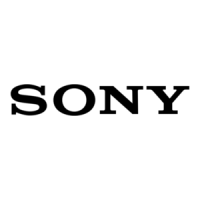2
ICD-U50/U60/U70
TABLE OF CONTENTS
1. GENERAL ................................................................... 3
2. DISASSEMBLY
2-1. Disassembly Flow ........................................................... 4
2-2. Cap Assy, Front Assy....................................................... 4
2-3. MAIN Board, Knob (JOG).............................................. 5
2-4. Speaker (1.0cm) (Sp901), Battery Lid,
Cabinet (Rear) Assy......................................................... 6
2-5. USB Board, USB Connector ........................................... 7
2-6. JACK Board, Electret Condenser Microphone
(MIC901) ......................................................................... 8
2-7. Button (RS), Knob (HOLD), Knob (DPC)...................... 9
3. TEST MODE ............................................................... 10
4. DIAGRAMS
4-1. Block Diagram ................................................................ 13
4-2. Printed Wiring Board – JACK Board – .......................... 14
4-3. Schematic Diagram – JACK Board – ............................. 15
4-4. Printed Wiring Boards – MAIN Board, USB Board – ... 16
4-5. Schematic Diagram – MAIN Board, USB Board – ....... 17
5. EXPLODED VIEWS
5-1. Overall Assy .................................................................... 21
5-2. Main Section.................................................................... 22
6. ELECTRICAL PARTS LIST .................................. 23
Flexible Circuit Board Repairing
• Keep the temperature of the soldering iron around 270 °C
during repairing.
• Do not touch the soldering iron on the same conductor of the
circuit board (within 3 times).
• Be careful not to apply force on the conductor when soldering
or unsoldering.
Notes on chip component replacement
• Never reuse a disconnected chip component.
• Notice that the minus side of a tantalum capacitor may be
damaged by heat.
UNLEADED SOLDER
Boards requiring use of unleaded solder are printed with the lead-
free mark (LF) indicating the solder contains no lead.
(Caution: Some printed circuit boards may not come printed with
the lead free mark due to their particular size)
: LEAD FREE MARK
Unleaded solder has the following characteristics.
• Unleaded solder melts at a temperature about 40 °C higher
than ordinary solder.
Ordinary soldering irons can be used but the iron tip has to be
applied to the solder joint for a slightly longer time.
Soldering irons using a temperature regulator should be set to
about 350 °C.
Caution: The printed pattern (copper foil) may peel away if
the heated tip is applied for too long, so be careful!
• Strong viscosity
Unleaded solder is more viscou-s (sticky, less prone to flow)
than ordinary solder so use caution not to let solder bridges
occur such as on IC pins, etc.
• Usable with ordinary solder
It is best to use only unleaded solder but unleaded solder may
also be added to ordinary solder. Operating instructiondd

